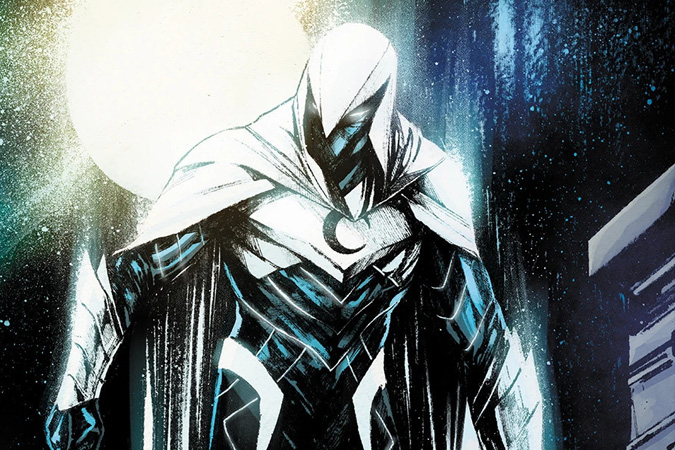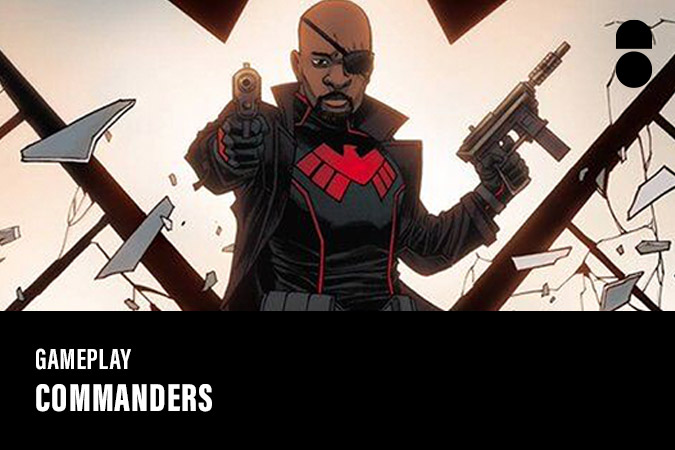Much of Marvel Multiverse RPG (as well as many TTRPGs) is focused on how player characters perform in combat. This leaves social encounters or downtime almost exclusively at the discretion of the Narrators. To address this, and give players options for downtime, side quests, leveling, and more, Absolute Overpower uses the concept of the Commander Overlay.
For those who have played turn-based strategy games like X-COM or Phantom Doctrine, the idea of a “commander overlay” should be familiar.
Each campaign has a “commander” or a team leader, controlled entirely by the Narrator outside of missions.
Commander Roles
The role of the Commander is to provide players in each campaign with a few basic elements.
- A Stronghold: a place familiar to the Commander that players will use as a Hub in between missions. Here they can interact with other players and NPCs during downtime activities. Doing so may unlock Stronghold-specific side-quests or other bonuses. They will also have access to Stronghold-specific labs, markets, etc., to unlock tools and weapons to use in the campaign by spending Karma.
- Commander Traits: each Commander bestows upon the party a Commander Trait unique to that Commander that is applied to each player (if desired), that can be used as long as that Commander is active.
- Team Maneuvers: In addition to a Commander trait, each Commander/Team should be given their own unique maneuver.
- Quests: Commanders act as the primary quest giver for each campaign. While each Commander has a main quest tied to the central plot of each campaign, as it progresses, Commanders will provide more and more side quests or additional objectives. Other NPCs at any given Stronghold can and will do the same provided the party (or a single player) has enough influence.
- Connections: one of the most important aspects of superhero stories is the wild team-ups, and you can’t have wild team-ups without connections. Individual players will often have connections as part of their backstory, tags, and traits, however, each Commander comes with a set of three connections of their own which players can use as long as that Commander is active (or they have built up the same connection independent of that Commander). Connections will also allow players to recruit connected heroes as NPCs during missions.
Commander Influence
Each campaign is given a starting Commander based on the main quest of that campaign. However, that does not mean that the party will keep that Commander. In comic books—perhaps more than anywhere—allegiances shift and motives change. Life-long friends can become bitter enemies.
This is true of Commanders as well. Over time parties will either gain or lose influence with their Commander. How influence is governed is dependent on the Narrator of each campaign, but it’s easy to presume that carrying out missions with a high success rate is important to commanders. As is seeking out things important to them, exploring their backstory or unique missions.
Inversely, it’s just as important for a party to decide they’re no longer aligned with a Commander. As the weight of a campaign mounts, a Commander may pursue objectives or methods that no longer align with the party or vice versa. A party might even stumble across a superhero NPC with the same main objectives but prefer their means. It is okay at any time for a party to go in a direction away from their Commander and change every aspect of the Overlay.
Note on Commander Influence
At no point should a Commander become antagonistic toward the party. In general, Commander Influence should always trend positively. It should be worked out with any party when they want to change Commanders, and how to do so, whether to roleplay it or automatically switch.
This desire could happen for many reasons, most of which come from the actions of the players during missions, or things they learn throughout the campaign. They might also just want to try something new. Or the players might just really like another character more! All reasons are valid, and none are more important than the other.
Commanders as PCs and NPCs
Players should feel free to play characters that also serve as the campaign’s Commander. However, it’s not advised they control the Commander’s actions, as it’s only successfully steered by the Narrator. Likewise, Narrators should never create a Narrator PC of the Commander character as it’s bound to negatively affect player agency. These roles should be kept discrete and individual, and a Commander should be thought of as nothing more than an NPC at the Stronghold who offers wayfinding through the campaign. On the other side, players controlling a Commander character should feel free to approach downtime activities as they normally would.
That said, players—whether they control a Commander character or not—should always be consulted with, and ultimately steer the direction of the campaign based on the information available to them.
Example Commander

To show how the Commander Overlay works in practice, we’ll use an example campaign based on The Midnight Mission.
In current Marvel Comics, Moon Knight has set up an agency called “The Midnight Mission” where he protects “those that travel at night,” throughout the neighborhood he patrols.
In this example campaign, Moon Knight will serve as Commander for a party that includes Batman and Daredevil (because they both have similar drives, protecting their chosen neighborhoods), Robin, Elektra, and Catwoman.
The Stronghold for this campaign is Midnight Mission (or House of Shadows), a sentient haunted house that protects those serving Moon Knight and eats his enemies.
Moon Knight provides the party with the Commander Trait “Lunar Imbalance” which gives each player in the party an additional level of damage reduction at night.
At the Stronghold, players can develop bonds and connections to receive quests from Tigra, Reese, Hunter’s Moon, Ragman, and even the House of Shadows itself.
Moon Knight also has connections to mercenaries, vigilantes, and deities. This gives the party access to an armory filled with weapons and firearms and a mausoleum to store bestowed religious relics. They can also recruit NPCs like Punisher, Scarlet Scarab, and Silver Sable.
However, the increasing access to firearms doesn’t sit well with the Batman, Daredevil, and Robin players. The increasingly erratic, violent, and mystic resolve with which Moon Knight approaches his mission also starts to feel at odds with how the party wants to approach the campaign. During a mission where the players venture into Shadowland, they rescue Luke Cage, who is level-headed, down to Earth, and not nearly as bloodthirsty. They decide that he is a better Commander for their mission.
Moon Knight is replaced, and Tigra, Reese, and Hunter’s Moon all go with him given their strong ties. Ragman remains as an NPC for this new version of The Midnight Mission. The whole party relocates to Luke Cage’s spot in Shadowland and replaces “Lunar Imbalance” with “Bulletproof Resolve” which gives the party -2 Damage Reduction on all incoming attacks made with firearms. This reflects the party’s resistance to using guns. Their connections change to include martial artists, and alongside Ragman, Iron Fist becomes an NPC at the Stronghold.
